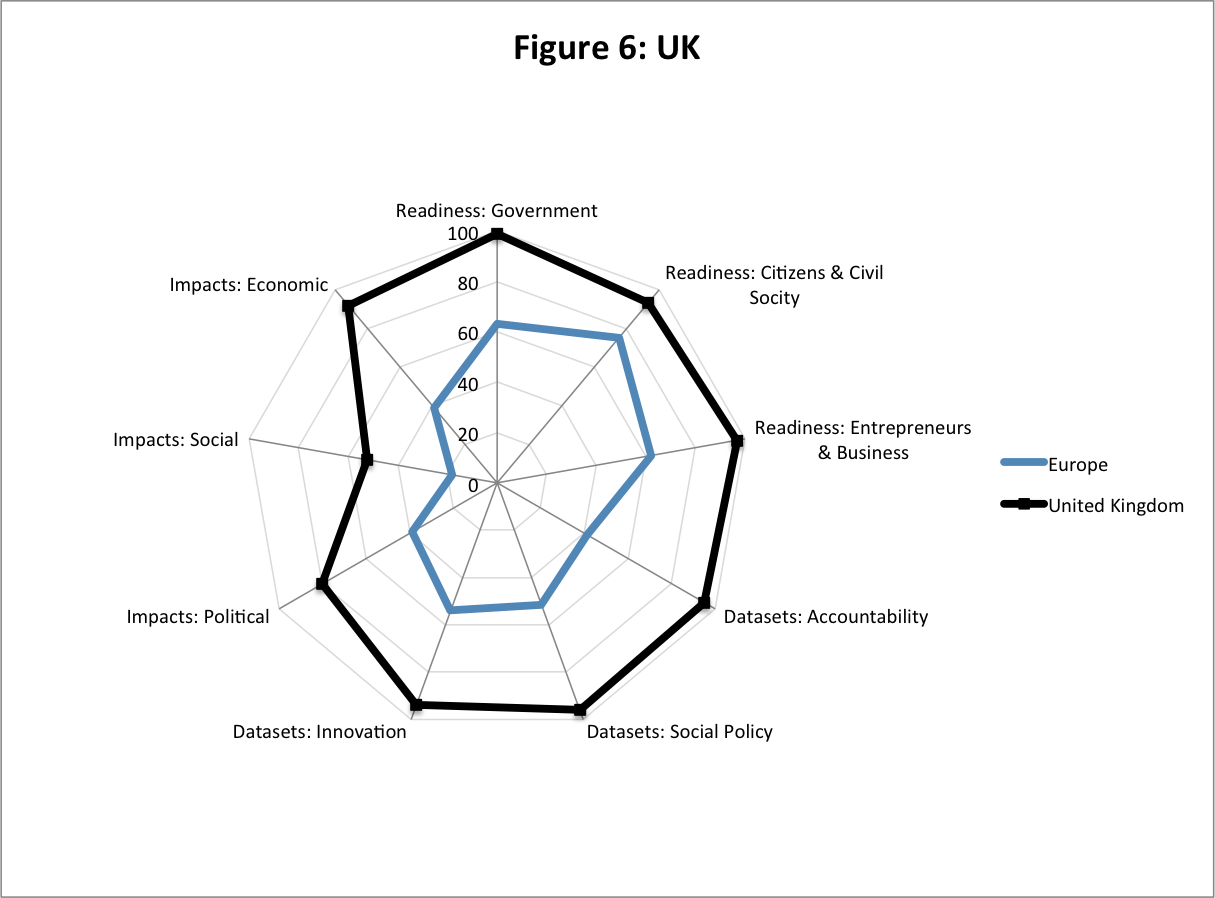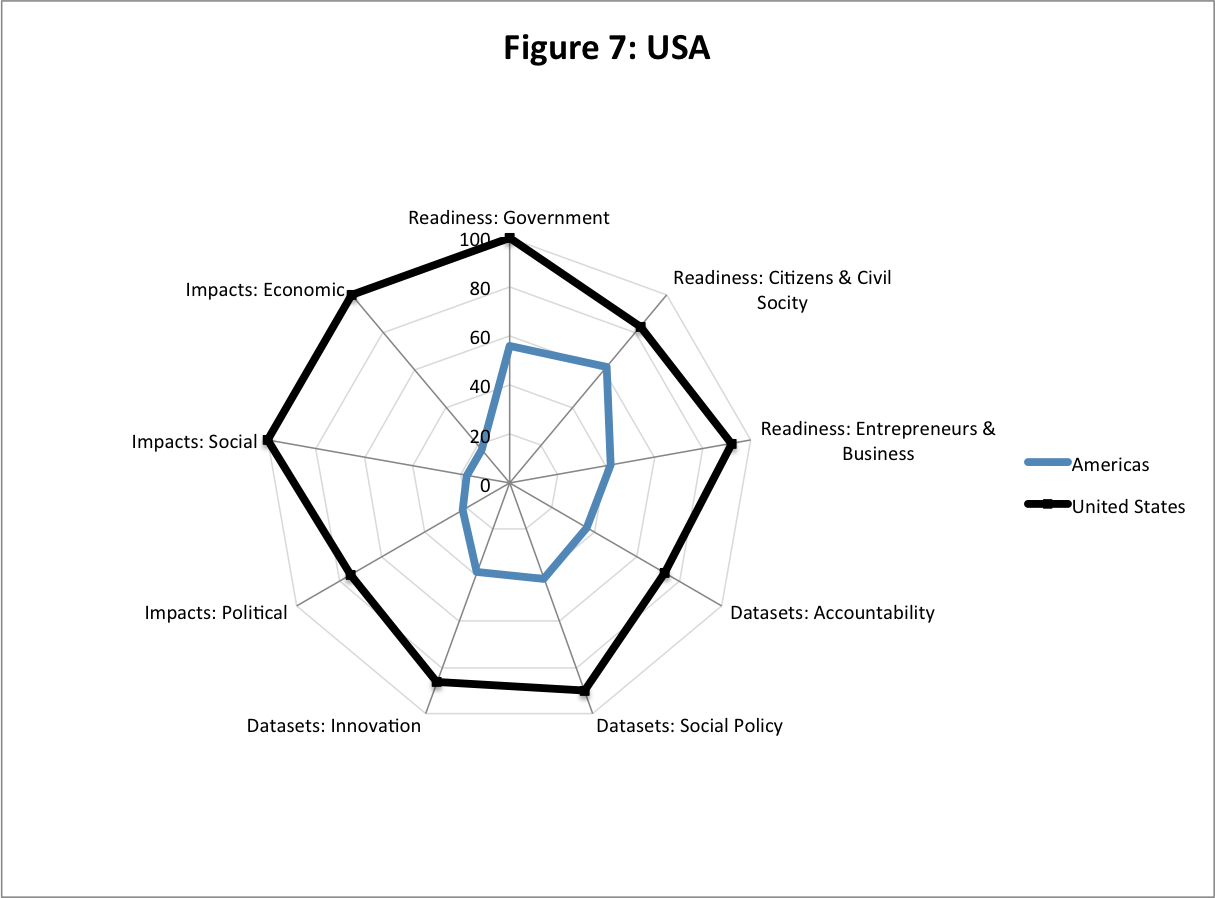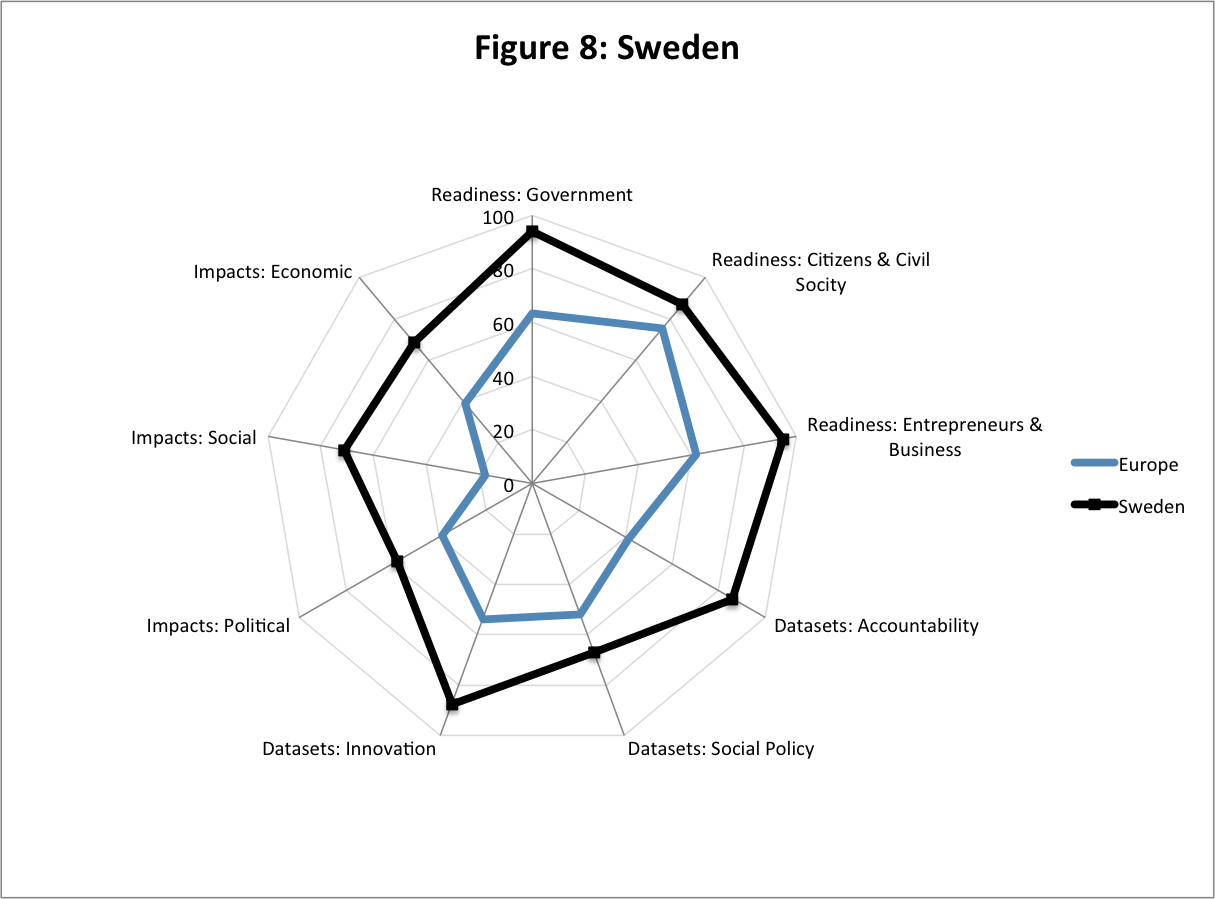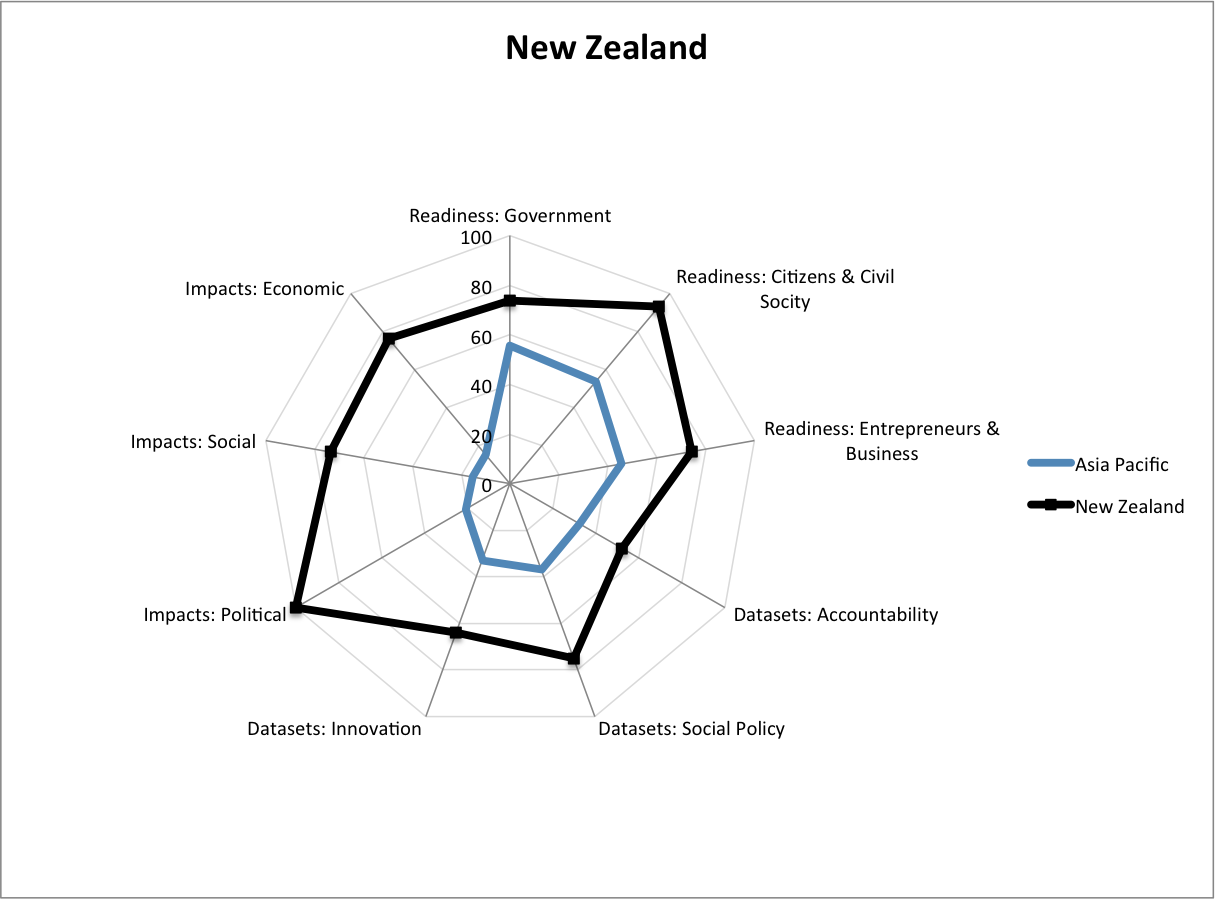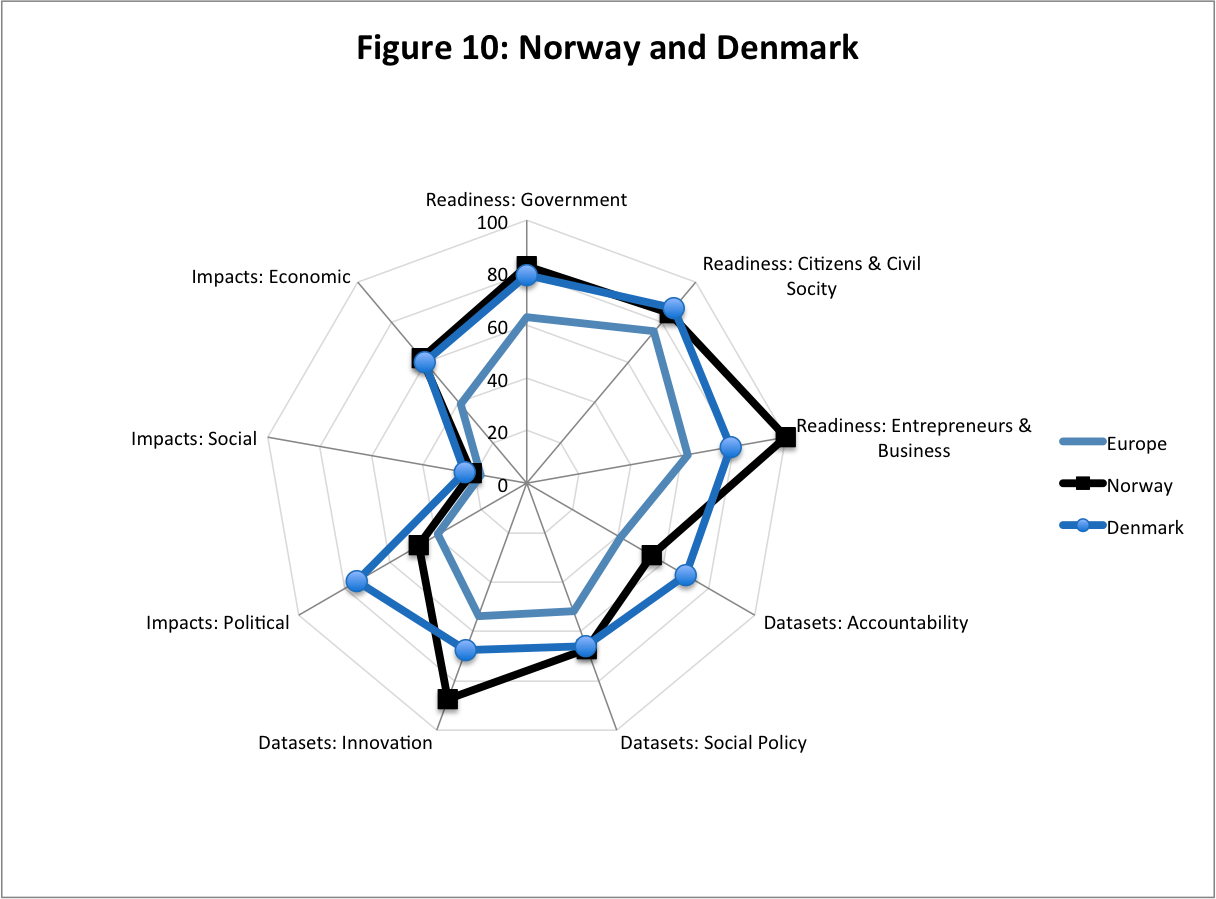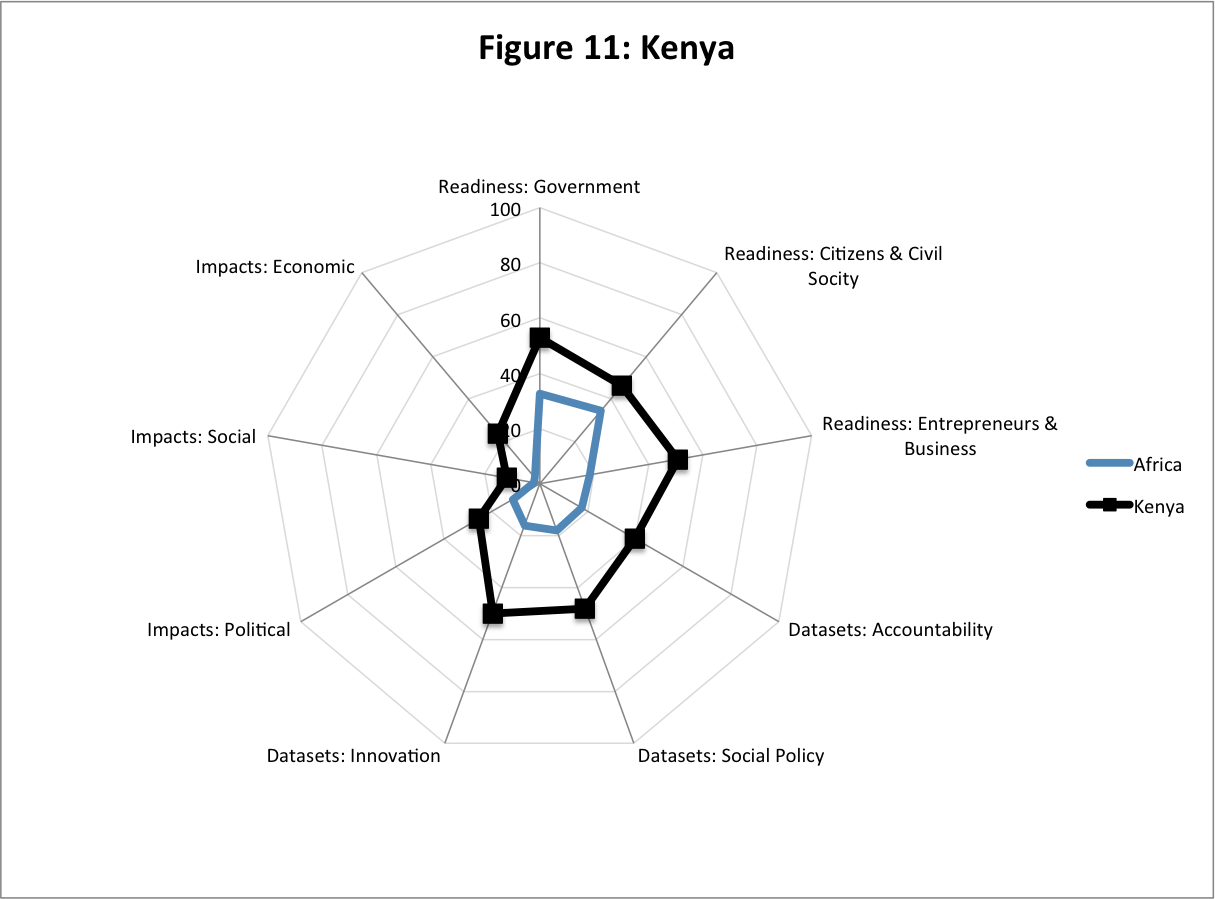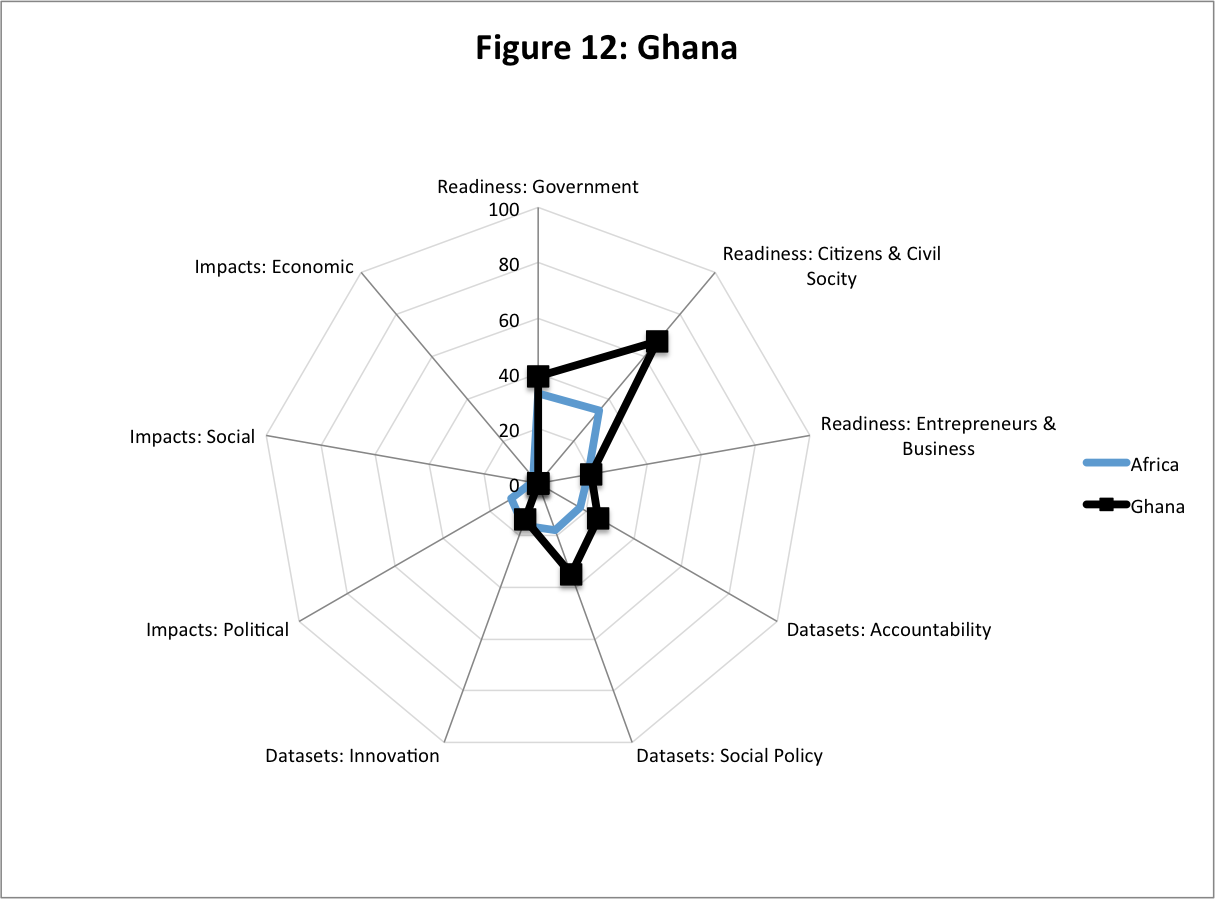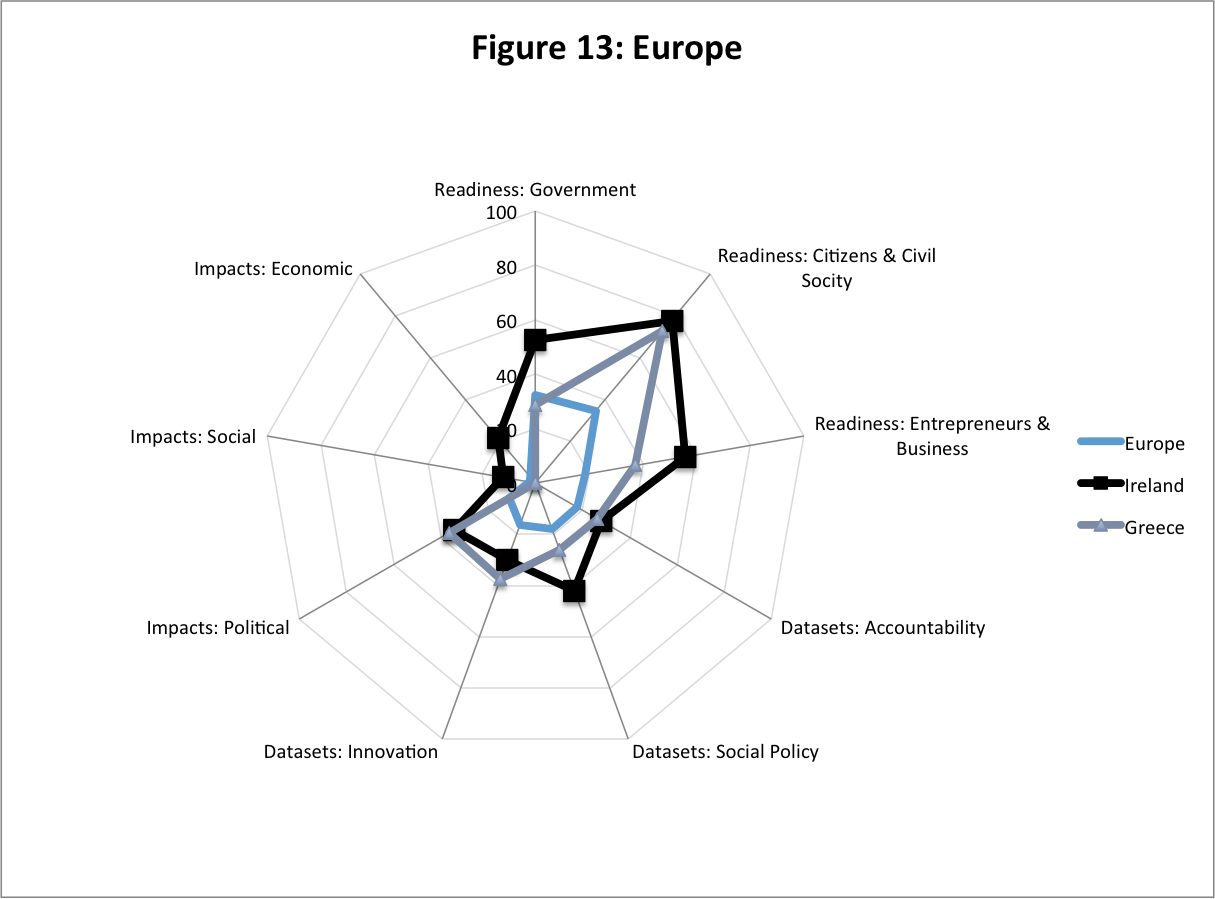The Open Data Barometer forms part of a research project into common assessment methods for open data initiatives. Through this we are seeking to identify measurement approaches that can help inform open data policy and practice, allowing governments, citizens and businesses to understand the relative maturity of different Open Government Data (OGD) initiatives, and to identify key areas for proactive interventions that can unlock the potential of government data in diverse contexts. Through the process of creating an index we are creating a shared resource that can be used to explore various hypotheses about the development of OGD. In addition through presenting data here, we offer a starting point for further exploration and storytelling about the commonalities and differences in OGD across the world. Our index is necessarily a subjective construction: although one informed by wider research and theory. In this section we outline the construction of the Open Data Barometer rankings. You will also find details of how you can access our data and create your own interpretations and analysis of open data across the globe.
Barometer structure and calculation
The Open Data Barometer is structured in three sub-indices to reflect the different stages involved in realising the benefits of open data, and the different groups who may be involved in, and may benefit from, open data. The three sections are readiness, implementation and impact.
Readiness - identifies how far a country has in place the political, social and economic foundations for realising the potential benefits of open data. This sub-index contains three components:
- Government: recognising the need for governments to have political will for an OGD initiative, and the technical capacity to put an OGD initiative into place;
- Entrepreneurs and business: recognising the key role played by innovators and established firms as re-users and intermediaries of government data – and identifying the extent of existing capacity and support for open data use available to the private sector;
- Citizen and civil society: recognising the importance of political freedoms, rights and protections to allow citizens and civil society to use OGD to hold government to account, and to engage in improving policy;
Implementation - identifies the extent to which government has published a range of key datasets to support innovation, accountability and more improved social policy. This sub-index contains three components, picking out clusters of datasets commonly used in:
- Securing government accountability;
- Improving social policy;and
- Enabling innovation and economic activity.
Emerging impacts – identifies the extent to which open data has been seen to lead to positive political, social and environment, and economic change. This sub-index contains three components:
- Political impacts – including transparency & accountability, and improved government efficiency and effectiveness;
- Economic impacts – through supporting start-up entrepreneurs and existing businesses;
- Social impacts – including environmental impacts, and contributing to greater inclusion for marginalised groups in society.
In the following sections we display detailed scores from each sub-index for each country, along with an overall score, and then provide a detailed breakdown of component scores for selected countries. This helps to highlight the relative strengths and weaknesses across different countries and regions, and to focus attention on areas for deeper investigation.
Calculating the rankings
To calculate each component an average of the variables in that component is taken. The average of components is used to generate each sub-index. Details of the variables in each component and sub-index can be found in the Annexe. For consistency, the normalised scores for all the sub-indexes, and the readiness and impacts components, have been rescaled to a 0 - 100 range using the formula [(x - min)/(max - min)]x100 prior to presentation. This means that a score of 100 on these components and sub-indexes illustrates the highest scoring country across the 77 included in the Barometer Global ranking. It does not mean that a score of 100 is perfect.
All scores in a study of this kind are subject to a margin of error. To offer an indicative comparison between countries we offer a ranking based on rounding each countries overall ODB score to its integer value (no decimal places), and placing countries in order of score. This ranking, and each of the other scores, should be treated as the starting point for exploration, rather than a definitive judgement on each countries open data readiness, implementation and impacts.
Country selection
The selection of countries covered in the Open Data Barometer is based upon those included in the forthcoming 2013 Web Index, with four exceptions due to difficulty sourcing primary data on time. This sample was selected to represent a wide range of regions, levels of development and political systems. The list of countries included in the Open Data Barometer is: Argentina, Australia, Austria, Bahrain, Bangladesh, Belgium, Benin, Botswana, Brazil, Burkina Faso, Cameroon, Canada, Chile, China, Colombia, Costa Rica, Czech Republic, Denmark, Ecuador, Estonia, Ethiopia, Finland, France, Germany, Ghana, Greece, Hungary, Iceland, India, Indonesia, Ireland, Israel, Italy, Jamaica, Japan, Jordan, Kazakhstan, Kenya, Korea, Republic of, Malawi, Mali, Mauritius, Mexico, Morocco, Namibia, Nepal, Netherlands, New Zealand, Nigeria, Norway, Pakistan, Peru, Philippines, Portugal, Qatar, Russian Federation, Rwanda, Saudi Arabia, Senegal, Singapore, South Africa, Spain, Sweden, Switzerland, Tanzania, United Republic of, Thailand, Tunisia, Turkey, UAE, Uganda, United Kingdom, United States of America, Uruguay, Venezuela, Yemen, Zambia and Zimbabwe.
Get the data
The full data used to compute the Open Data Barometer is available from http://www.opendatabarometer.org Open Data Barometer data is also archived with the Zenodo research archive at https://zenodo.org/collection/user-opendatabarometer. Zenodo is a permanent research archive hosted on CERN infrastructure, dedicated to the long-term archival of research data.
With the release of this report a number of files have been published.
| Filename | Description |
|---|---|
| Open Data Barometer - Research Handbook.pdf | The detailed research handbook providing the full text of questions and source guidance used in the expert-survey. |
| ODB-2013-Rankings.csv | The calculated components and sub-indexes of the 2013 Open Data Barometer. |
| ODB-2013-Structure.csv | All input variables included in the Open Data Barometer, their source and definition |
| ODB-2013-ScoresMatrix.csv | Peer-reviewed numerical scores assigned to each primary data variable collected for the Open Data Barometer. |
| ODB-2013-Datasets-Scored.csv | Validated and weighted dataset assessments; one row per dataset per country. |
| ODB-2013-Calculations.xls | Primary and secondary data, along with calculations and final index values. |
All data is licensed under the Open Data Commons Attribution License. Please cite as: Web Foundation, “Open Data Barometer: 2013 Global Report – Datasets” and include a link to www.opendatabarometer.org when re-using the data. Better still, get in touch to let us know about any re-use or analysis you have made. E-mail project-odb@webfoundation.org or visit www.opendataresearch.org/network/ to find our online discussion spaces.
Global ranking: results
The table below presents global rankings of the Barometer index. Scores on each sub-index are based on normalised and scaled data, so indicate the comparative position of countries.
| Country | Rank | Readiness Sub-Index | Implementation Sub-Index | Impact Sub-Index | ODB Overall |
|---|---|---|---|---|---|
| United Kingdom | 1 | 100.00 | 100.00 | 79.91 | 100.00 |
| United States | 2 | 95.26 | 86.67 | 100.00 | 93.38 |
| Sweden | 3 | 95.20 | 83.14 | 71.95 | 85.75 |
| New Zealand | 4 | 81.88 | 65.49 | 89.81 | 74.34 |
| Norway | 5 | 91.88 | 70.98 | 46.15 | 71.86 |
| Denmark | 5 | 83.54 | 70.20 | 55.73 | 71.78 |
| Australia | 7 | 87.88 | 64.71 | 51.19 | 67.68 |
| Canada | 8 | 79.11 | 63.92 | 51.59 | 65.87 |
| Germany | 9 | 74.50 | 63.14 | 53.81 | 65.01 |
| France | 10 | 79.39 | 64.31 | 39.07 | 63.92 |
| Netherlands | 10 | 85.92 | 67.06 | 21.42 | 63.66 |
| Korea (Rep. of) | 12 | 77.19 | 54.90 | 24.56 | 54.21 |
| Iceland | 13 | 62.99 | 52.94 | 26.45 | 51.01 |
| Estonia | 14 | 72.38 | 49.41 | 24.00 | 49.45 |
| Finland | 14 | 91.19 | 41.18 | 40.87 | 49.44 |
| Japan | 14 | 76.99 | 47.06 | 27.94 | 49.17 |
| Spain | 17 | 67.48 | 49.41 | 21.13 | 48.19 |
| Austria | 18 | 68.56 | 39.22 | 48.62 | 46.03 |
| Israel | 18 | 61.82 | 45.88 | 25.36 | 45.58 |
| Italy | 20 | 50.39 | 42.75 | 45.69 | 45.30 |
| Russia | 20 | 54.43 | 40.39 | 48.86 | 44.79 |
| Switzerland | 22 | 65.11 | 41.57 | 26.80 | 43.24 |
| Czech Republic | 22 | 61.83 | 40.00 | 35.36 | 43.18 |
| Kenya | 22 | 49.70 | 45.88 | 21.55 | 43.06 |
| Mexico | 25 | 49.10 | 45.49 | 8.37 | 40.30 |
| Chile | 25 | 65.79 | 39.22 | 18.27 | 40.11 |
| Portugal | 27 | 60.38 | 38.04 | 19.25 | 38.63 |
| Brazil | 28 | 66.03 | 32.16 | 27.87 | 36.83 |
| Singapore | 29 | 70.28 | 35.29 | 8.97 | 36.29 |
| Ireland | 29 | 61.81 | 32.55 | 23.92 | 35.76 |
| Thailand | 31 | 38.09 | 39.22 | 14.88 | 35.33 |
| Argentina | 31 | 46.08 | 36.47 | 17.29 | 35.00 |
| Belgium | 31 | 72.01 | 28.63 | 25.64 | 34.80 |
| India | 34 | 57.36 | 33.73 | 9.87 | 33.38 |
| Uruguay | 34 | 54.66 | 32.94 | 13.31 | 33.04 |
| Costa Rica | 36 | 47.34 | 35.29 | 0.00 | 31.21 |
| Kazakhstan | 37 | 34.96 | 32.16 | 2.84 | 27.61 |
| Greece | 37 | 43.95 | 27.84 | 12.30 | 27.59 |
| Turkey | 37 | 41.92 | 31.37 | 0.00 | 27.58 |
| Morocco | 40 | 36.46 | 27.84 | 16.59 | 27.24 |
| Colombia | 40 | 44.33 | 29.02 | 2.49 | 26.71 |
| Hungary | 42 | 32.42 | 28.63 | 10.51 | 26.09 |
| Mauritius | 42 | 35.71 | 30.59 | 0.00 | 26.08 |
| United Arab Emirates | 44 | 53.88 | 21.57 | 12.30 | 24.59 |
| Rwanda | 45 | 36.71 | 27.84 | 0.00 | 24.27 |
| Jamaica | 46 | 32.56 | 25.88 | 2.49 | 22.69 |
| Philippines | 47 | 40.33 | 21.18 | 10.31 | 21.91 |
| Peru | 47 | 36.36 | 23.14 | 4.95 | 21.74 |
| Ghana | 47 | 39.51 | 23.53 | 0.00 | 21.60 |
| Ecuador | 50 | 38.51 | 22.35 | 2.83 | 21.12 |
| Tunisia | 50 | 63.52 | 10.98 | 26.46 | 21.02 |
| South Africa | 52 | 35.39 | 18.43 | 10.31 | 19.20 |
| Indonesia | 52 | 34.91 | 20.39 | 0.00 | 18.66 |
| Bahrain | 54 | 42.94 | 18.04 | 0.00 | 18.18 |
| Uganda | 55 | 23.99 | 13.33 | 23.07 | 16.15 |
| Botswana | 55 | 12.16 | 21.57 | 0.00 | 16.08 |
| Nepal | 55 | 21.15 | 18.43 | 2.84 | 15.70 |
| Tanzania | 58 | 20.43 | 17.65 | 0.00 | 14.51 |
| Malawi | 59 | 28.24 | 11.76 | 16.52 | 14.47 |
| Qatar | 60 | 39.01 | 11.76 | 0.00 | 13.09 |
| China | 61 | 41.72 | 9.41 | 0.00 | 11.82 |
| Venezuela | 62 | 9.59 | 14.90 | 0.00 | 10.91 |
| Pakistan | 63 | 14.59 | 12.16 | 0.00 | 9.70 |
| Jordan | 63 | 30.95 | 8.63 | 0.00 | 9.63 |
| Bangladesh | 63 | 23.00 | 10.20 | 0.00 | 9.56 |
| Ethiopia | 66 | 15.45 | 10.59 | 0.00 | 8.70 |
| Burkina Faso | 67 | 17.63 | 8.24 | 0.00 | 7.35 |
| Benin | 67 | 11.60 | 9.41 | 0.00 | 7.28 |
| Saudi Arabia | 67 | 40.82 | 1.57 | 5.69 | 7.09 |
| Namibia | 67 | 11.57 | 9.02 | 0.00 | 7.00 |
| Senegal | 71 | 28.57 | 4.71 | 0.00 | 6.46 |
| Cameroon | 71 | 7.11 | 6.67 | 5.56 | 5.65 |
| Zimbabwe | 73 | 15.20 | 5.88 | 0.00 | 5.30 |
| Yemen | 73 | 0.00 | 8.24 | 0.00 | 4.69 |
| Nigeria | 75 | 36.90 | 0.00 | 0.00 | 4.35 |
| Zambia | 75 | 11.84 | 5.10 | 0.00 | 4.23 |
| Mali | 77 | 6.15 | 0.39 | 0.00 | 0.00 |
| Grand Total | 47.99 | 32.20 | 18.62 | 32.47 |
Table 4: Sub-index and overall scores. Each column independently scaled on a 0 - 100 min-max scale (i.e. 100 = top scorer out of our sample; but does not indicate a perfect score on that component). Rank based on rounded integer value of overall score.
Country analysis: top five
Table 4 shows a clear regional variation between the readiness, implementation and impact scores assigned by the Open Data Barometer. In the following pages we explore the scores of selected countries, and dig into the narratives behind these scores, drawing on secondary literature and the qualitative data gathered during the Barometer survey. The focus here is on drawing out lessons from OGD initiative strengths, and highlighting unique aspects of different initiatives, rather and providing a full critical assessment of each initiative, and these narratives should be read in light of the substantial distance all countries still have to travel before they can claim to be fully ‘open by default’.
United Kingdom (Overall rank #1)
The UKs weakest area in the Barometer ranking is in securing social impact from open data, and although there are some experiments taking place to make community and local government data available to support policy discussions, recent government policy has particularly emphasised economic re-use of data, and requiring economically-centred ‘business cases’ to justify data release, rather than looking to support thematic communities of practice around data. Only limited examples of open data used as a tool for more open policy making exist. Concerns have also been raised that the ‘open by default’ principle the government signed up to in the G8 Open Data Charter (G8, 2013) may not be applied to important new datasets such as a register of company beneficial ownership being created to address tax dodging and corruption. Civil society organisations have criticised the government’s reluctance to make an explicit commitment to providing this as open data, and slow progress on providing existing comprehensive data from the companies register.
Across the extensive data that is provided by the government, there are clear efforts to increase quality, standardisation, reliability and link-ability. A number of datasets surveyed in the barometer (national map, land registry, company registry, and legislation) are available as five star linked data. In response to a 2013 independent review of Public Sector Information policy (Shakespeare, 2013), the UK is now increasingly focussed on articulating and developing a National Information Infrastructure of core datasets that need to be maintained, developed and enhanced as open data. A number of departments are exploring how to build their public web presence on top of their open data publication, creating platforms that are ‘open all the way down’, including legislation.gov.uk, and the http://devtracker.dfid.gov.uk site which brings together IATI standard aid transparency data from different government departments.
United States (Overall rank #2)
The US government has placed a strong emphasis on bringing innovators into government, and increasing engagement between government and outside communities, linked to the idea of ‘government as a platform’ (O’Reilly, 2010). A programme of ‘Presidential Innovation Fellows’ has seen private sector experts embedded in government departments on short-term placement to support open data work, and a series of high-profile ‘Datapalooza’ events sought to engage entrepreneurs in solving social problems and building businesses using government data. The US also benefits from a wide range of civil society organisations seeking to work with government data for transparency and accountability purposes.
There has been a particular emphasis placed in the development of the data.gov data portal placed on the ‘Communities’ section, creating thematic spaces that bring together content, documentation and discussions on topics such as agriculture, health, energy, law and manufacturing. However, recent experiences of the US Government Shutdown highlighted the weaknesses of a centralised data portal approach, when access to data.gov was turned off for two weeks – leaving anyone relying on Open Government Data without access to this essential resource.
Sweden (Overall rank #3)
Sweden’s OGD portal does face some weaknesses when it comes to clear licencing, with a number of key datasets published without an open licence. The portal itself is managed by the Vinnova, the National Innovation Agency, and has a dedicated staff who have also been involved in supporting pilot open data projects in different cities and organisations across Sweden.
Hack day and innovation events have taken place across the country to stimulate engagement with data, and projects such as TrafikLab bring together public and private data on transport in one platform for innovators to build on. Sweden scores particularly highly across the impact components of the Barometer, with examples of open data use to improve the efficiency of healthcare, and use of environmental data by data journalists to visualise how cuts to the environment budget might affect endangered species.
New Zealand (Overall rank #4)
Whilst there is a civil society community engaging with government around open data in New Zealand, the community is relatively small. There have been some hack day events and app competitions since 2010, but government has not yet widely experimented with grants, innovation vouchers or incubator programmes to stimulate entrepreneurial re-use of open data.
The New Zealand Government has put considerable effort into monitoring progress towards open government and open data, with Agencies asked to regularly report to Ministers on their progress, case studies collated on re-uses of open data, and an annual reporting process on adoption of the Declaration on Open and Transparent Government. New Zealand was one of the few countries in the Barometer where a significant emphasis on environmental impacts of open data could be observed, with a wide range of environmental datasets made available and seeing re-use, particularly in supporting coordination around extreme weather and geological events.
Denmark and Norway (Overall joint rank #5)
Denmark and Norway both rank highly in the Open Data Barometer, with governments, civil society and businesses well placed to secure benefits from open data. Both countries also have a broad range of data available in machine-readable and bulk formats, although their strategies to achieve this vary.
In Norway, an open data platform has been undergoing iterative development since 2010, with a blog initially launched to engage the community, and then a data catalogue launched in 2011. Run by the Agency for Public Management and eGovernment (Difi), the platform has also created the ‘Data Hotel’, a hosted API and data store which will host machine-readable copies of government data through a common API, and which provides stable URIs (links) for many elements in these datasets. The Data Hotel is offered as an optional service to government agencies publishing on the data.norge.no portal, allowing them to increase the accessibility of their data for users.
Norway is one of the three countries in the Barometer with a fully open company register, and has reported strong uptake, including from the business community who are using API access onto the register for e-invoicing, clocking up over 190,000 hits a month within the first year.
It is notable in the radar chart above that Denmark demonstrates higher availability of accountability datasets and stronger political impacts, whilst also seeing lower business readiness to engage with open data and secure benefits from it, along with lower availability of innovation enabling datasets. However, access to data has still had a substantial economic impact in Denmark. In 2002 the government launched an agreement to provide free of charge access to address data. A 2010 evaluation of the policy commissioned by the Danish Enterprise and Construction Authority found that 1,200 parties were consuming the data via 22 public data distributors, with an estimated financial benefit to society of EUR 62 million, against costs to 2009 of only EUR 2 million (DECA, 2010). Although not framed in terms of open data, this policy demonstrates the importance of key datasets as inputs for a wide range of business activities.
Regional rankings
The table below presents Barometer rankings grouped by region.
| Country | Readiness Sub-Index | Implementation Sub-Index | Impact Sub-Index | ODB Overall |
|---|---|---|---|---|
| Africa | 25.90 | 14.73 | 5.72 | 14.29 |
| Kenya | 49.70 | 45.88 | 21.55 | 43.06 |
| Morocco | 36.46 | 27.84 | 16.59 | 27.24 |
| Mauritius | 35.71 | 30.59 | 0.00 | 26.08 |
| Rwanda | 36.71 | 27.84 | 0.00 | 24.27 |
| Ghana | 39.51 | 23.53 | 0.00 | 21.60 |
| Tunisia | 63.52 | 10.98 | 26.46 | 21.02 |
| South Africa | 35.39 | 18.43 | 10.31 | 19.20 |
| Botswana | 12.16 | 21.57 | 0.00 | 16.08 |
| Uganda | 23.99 | 13.33 | 23.07 | 16.15 |
| Tanzania | 20.43 | 17.65 | 0.00 | 14.51 |
| Malawi | 28.24 | 11.76 | 16.52 | 14.47 |
| Ethiopia | 15.45 | 10.59 | 0.00 | 8.70 |
| Burkina Faso | 17.63 | 8.24 | 0.00 | 7.35 |
| Benin | 11.60 | 9.41 | 0.00 | 7.28 |
| Namibia | 11.57 | 9.02 | 0.00 | 7.00 |
| Senegal | 28.57 | 4.71 | 0.00 | 6.46 |
| Cameroon | 7.11 | 6.67 | 5.56 | 5.65 |
| Zimbabwe | 15.20 | 5.88 | 0.00 | 5.30 |
| Zambia | 11.84 | 5.10 | 0.00 | 4.23 |
| Nigeria | 36.90 | 0.00 | 0.00 | 4.35 |
| Mali | 6.15 | 0.39 | 0.00 | 0.00 |
| Americas | 51.13 | 37.50 | 19.19 | 36.84 |
| United States | 95.26 | 86.67 | 100.00 | 93.38 |
| Canada | 79.11 | 63.92 | 51.59 | 65.87 |
| Mexico | 49.10 | 45.49 | 8.37 | 40.30 |
| Chile | 65.79 | 39.22 | 18.27 | 40.11 |
| Brazil | 66.03 | 32.16 | 27.87 | 36.83 |
| Argentina | 46.08 | 36.47 | 17.29 | 35.00 |
| Uruguay | 54.66 | 32.94 | 13.31 | 33.04 |
| Costa Rica | 47.34 | 35.29 | 0.00 | 31.21 |
| Colombia | 44.33 | 29.02 | 2.49 | 26.71 |
| Jamaica | 32.56 | 25.88 | 2.49 | 22.69 |
| Peru | 36.36 | 23.14 | 4.95 | 21.74 |
| Ecuador | 38.51 | 22.35 | 2.83 | 21.12 |
| Venezuela | 9.59 | 14.90 | 0.00 | 10.91 |
| Asia Pacific | 51.18 | 33.24 | 18.49 | 33.67 |
| New Zealand | 81.88 | 65.49 | 89.81 | 74.34 |
| Australia | 87.88 | 64.71 | 51.19 | 67.68 |
| Korea (Rep. of) | 77.19 | 54.90 | 24.56 | 54.21 |
| Japan | 76.99 | 47.06 | 27.94 | 49.17 |
| Singapore | 70.28 | 35.29 | 8.97 | 36.29 |
| Thailand | 38.09 | 39.22 | 14.88 | 35.33 |
| India | 57.36 | 33.73 | 9.87 | 33.38 |
| Philippines | 40.33 | 21.18 | 10.31 | 21.91 |
| Indonesia | 34.91 | 20.39 | 0.00 | 18.66 |
| Nepal | 21.15 | 18.43 | 2.84 | 15.70 |
| China | 41.72 | 9.41 | 0.00 | 11.82 |
| Pakistan | 14.59 | 12.16 | 0.00 | 9.70 |
| Bangladesh | 23.00 | 10.20 | 0.00 | 9.56 |
| Europe | 68.97 | 50.12 | 35.34 | 51.50 |
| United Kingdom | 100.00 | 100.00 | 79.91 | 100.00 |
| Sweden | 95.20 | 83.14 | 71.95 | 85.75 |
| Norway | 91.88 | 70.98 | 46.15 | 71.86 |
| Denmark | 83.54 | 70.20 | 55.73 | 71.78 |
| Germany | 74.50 | 63.14 | 53.81 | 65.01 |
| France | 79.39 | 64.31 | 39.07 | 63.92 |
| Netherlands | 85.92 | 67.06 | 21.42 | 63.66 |
| Iceland | 62.99 | 52.94 | 26.45 | 51.01 |
| Estonia | 72.38 | 49.41 | 24.00 | 49.45 |
| Finland | 91.19 | 41.18 | 40.87 | 49.44 |
| Spain | 67.48 | 49.41 | 21.13 | 48.19 |
| Austria | 68.56 | 39.22 | 48.62 | 46.03 |
| Italy | 50.39 | 42.75 | 45.69 | 45.30 |
| Russia | 54.43 | 40.39 | 48.86 | 44.79 |
| Switzerland | 65.11 | 41.57 | 26.80 | 43.24 |
| Czech Republic | 61.83 | 40.00 | 35.36 | 43.18 |
| Portugal | 60.38 | 38.04 | 19.25 | 38.63 |
| Ireland | 61.81 | 32.55 | 23.92 | 35.76 |
| Belgium | 72.01 | 28.63 | 25.64 | 34.80 |
| Greece | 43.95 | 27.84 | 12.30 | 27.59 |
| Turkey | 41.92 | 31.37 | 0.00 | 27.58 |
| Hungary | 32.42 | 28.63 | 10.51 | 26.09 |
| Middle East & C. Asia | 38.05 | 18.48 | 5.77 | 18.81 |
| Israel | 61.82 | 45.88 | 25.36 | 45.58 |
| Kazakhstan | 34.96 | 32.16 | 2.84 | 27.61 |
| United Arab Emirates | 53.88 | 21.57 | 12.30 | 24.59 |
| Bahrain | 42.94 | 18.04 | 0.00 | 18.18 |
| Qatar | 39.01 | 11.76 | 0.00 | 13.09 |
| Jordan | 30.95 | 8.63 | 0.00 | 9.63 |
| Saudi Arabia | 40.82 | 1.57 | 5.69 | 7.09 |
| Yemen | 0.00 | 8.24 | 0.00 | 4.69 |
| Grand Total | 47.99 | 32.20 | 18.62 | 32.47 |
Table 5: Sub-index and overall scores. Each column independently scaled on a 0 - 100 min-max scale (i.e. 100 = top scorer out of our sample; but does not indicate a perfect score on that component).
Regional analysis: Africa
The first OGD initiative in Africa was launched in Morocco in April 2011, closely followed by Kenya in July of that year. A number of other countries have explored creating OGD initiatives, and international donors such as the World Bank have been supporting open data readiness studies across the continent. Civil society groups have also engaged with campaigning for open data in countries such as Uganda and South Africa. The African Development Bank has launched the Open Data For Africa platform (www.opendataforafrica.org) bringing together key statistical indicators as open data from all 54 African countries, although we did not find any countries linking out to this portal or pointing their citizens to it. Where data was available from African governments, it was often provided through national statistical services, the beneficiaries of considerable investment in statistical capacity building over recent years. Adding support for these agencies to publish bulk machine-readable data, and to apply open licenses, could increase the supply of fully open data on the continent.
Budgets were also often published online in ways that are just a few steps from being fully open data. However, many important datasets will be trickier to secure as open data – as robust digital data collection and management is often lacking when it comes to information such as detailed public service performance, government spending, land registration, company registration and national maps. Given one of the factors underlying the role of OGD in stimulating entrepreneurial activity is the idea that government data is comprehensive and reliable (Lakomaa & Kallberg, 2013), models of open data based innovation in areas of Africa may need to develop new approaches, potentially based around open approaches to generating, rather than using, key public datasets.
Kenya (Overall rank #22)
Significant effort has gone into capacity building with the local technology community, and with journalists as key open data intermediaries. Initiatives include hack days, data journalism training, and the Code for Kenya incubator, which embedded data experts inside established news organisations. These projects have often faced challenges getting relevant data from the opendata.go.ke portal, but have managed to access datasets through data scraping and interacting directly with ministries, suggesting that the idea of open data has acted as a catalyst for a range of activities, even if open datasets are not, in the end, the main input to those activities.
Civil society groups have also engaged with the open data agenda, exploring how open data could be a resource for informing and empowering marginalised communities. Early research suggests that there is a long way to go before the impacts of the open data initiative are widely felt. In a recent survey of Kenyan citizens, the Jesuit Hakamani Trust found that whilst there was significant demand from the population for government data, at most 14% of citizens were aware of, or had accessed, the national open data portal (Mokua & Chiliswa, 2013), and open data will need to be accessible through a range of non-technical intermediaries such as community centres and radio if the gap between information online, and effective access to information for citizens is to be bridged.
Morocco, Mauritius, Rwanda (Overall ranks #40, #42, #45)
Morocco launched an open data portal in April 2011, with a focus on financial datasets. The portal currently hosts 50 datasets, all placed under a clear Open Database License. There has been limited outreach around the portal, although the increased availability of budget and finance information has stimulated discussions about government transparency, and some local experimentation with different ways to visualise and use the data.
Neither Rwanda nor Mauritius currently have OGD initiatives, although Mauritius has included elements on open data within its 2013-17 eGovernment Strategy, focussing on its potential contribution to transparency, public service improvement, innovation and efficiency.
Ghana (Overall rank #47)
Ghana began an OGD Initiative in early 2012, following a readiness assessment carried outby the World Wide Web Foundation in May 2011. The Initiative has launched a ‘beta’ opendata portal for public comment, with around120 datasets from 12 departments, and is focussing on the development of clear opendata strategy and on building an open datacommunity in the country. Ghana recently passed a Right to Information Law, and hashad a data protection law on the books since2012, providing key foundations for trust in the OGD initiative. However, both laws are yet tobe fully tested in practice. With external supportthe government has run data journalism training, but there is a lot more to be done tobuild a community of intermediaries around the data published by government, and to increase the quality and reliability of key datasets as the open data portal moves from beta to a production version. 
Regional analysis: Europe
A number of European countries have already been discussed in the top five analyses. Looking at the overall picture for Europe, countries are generally strong on the civil society readiness component. This component includes issues such as the presence of Right to Information legislation, political freedoms, and the quality of Data Protection Laws. We hypothesise that clear data protection regimes are important for citizen trust in open data, and to ensure (a) that private data is not wrongly released during open data programmes; and (b) that open data cannot be easily abused by being combined with other retained records on individuals. European Union and Council of Europe instruments contribute strongly to the consistent and robust data protection regime in Europe.
The civil society readiness component also includes a variable concerning the extent of bottom-up campaigning for open data. A number of countries have well developed advocacy for open data, with broad coalitions of developers, academics and civil society, yet have not yet secured clear government commitment and action on open data. Notable examples include Ireland and Greece, both of which have also had a strong community focus on Linked Data.
With a few exceptions, whilst most European nations have high levels of internet penetration, and firms with capacity to absorb ICTs, there are considerable opportunities for governments to increase the availability of open data related training, and to invest in support for innovation and open data re-use in order to have a greater chance to gaining benefits from data publication.
Regional analysis: Middle East and Central Asia
Amongst the Middle East and Central Asia countries in the ODB sample only Yemen has no evidence of any Open Government Data activity. Bahrain, Kazakhstan and Israel each have dedicated open data portals, and the United Arab Emirates, Jordan and Qatar have created Open Government Data pages on existing government websites. Elbadawi’s argument that Gulf Coooperation Council open data initiatives are primarily e-government driven (Elbadawi, 2012) is supported by the ODB data, showing strong government technology capacity, but much more limited civil society and private sector readiness to secure benefits from open data. Without strong foundations of civil society freedoms, the Right to Information and Data Protection, it is likely to be far harder for transparency and accountability benefits of open data to be secured.
The region has also seen very little support for innovation with open data, suggesting the economic potential of open data will also be hard to realise. This raises questions about the motivation and drivers for the launch of open data portals and platforms.
Open data is written into a number of national e-government action plans in the region, and is a component of Jordan’s Open Government Partnership action plan. However, a pattern of stop-start OGD initiative development so far is apparent from our qualitative research. Bahrain’s OGD initiative delivered a portal in 2011, but it has been largely dormant since. In Israel, an OGD initiative began with ministerial backing, but progress appeared to slow when the minister involved left the government. Both appear to be receiving new attention, but a lack of sustained progress is likely to have harmed the confidence of potential users, and work will be needed to build community and re-user confidence in open data supply.
Regional analysis: Asia Pacific
Together the countries in our Asia Pacific regional grouping account for over 3.5bn of the world population, and represent a full range of levels in the Human Development Index (HDI).
In the low HDI countries (Bangladesh, Pakistan and Nepal) only Nepal has seen substantial activity around open data, although this is primarily led by civil society, and is substantially driven by an aid transparency agenda, recognising the substantial contribution that international donors make to the national budget. Amongst medium-ranked HDI countries (China, India, Indonesia, Philippines, and Thailand) there are a number of different approaches. China has a national initiative on ‘Open Government’, but no explicit open data initiative at the national level, although some activity is taking place in Shanghai City. Availability of key open datasets in China is amongst the lowest in the Barometer rankings. Indonesia and the Philippines are both at the early stages of developing OGD initiatives, with significant work to do to increase the availability of structured, machine-readable data. As Sunlight Foundation have recently argued, whilst the Philippines has good legally mandated disclosures of contracting information, as well as having strong incentives for local government units to publish information online, the absence of machine-readable open data makes searching through all this information challenging, and limits public engagement in the transparency and accountability process (Furnas, 2013). India’s Open Government Data initiative has built upon the introduction of the National Data Sharing and Accessibility Policy (NDSAP), and has led to the launch of the data.gov.in portal. The initiative is notable for publically announcing ‘data controllers’ for government ministries and departments, offering citizens and entrepreneurs a direct channel to data holders in various departments, rather than routing all communications with government through a central portal.
Amongst higher HDI countries, Japan’s Open Government Data policy has received a boost through the recent G8 Open Data Charter. New Zealand, South Korea, Australia, Japan and Singapore all have a high level of government and private sector readiness to secure benefits from open data, although civil society readiness is notably lower in Singapore and Korea.
Regional analysis: Latin America and the Caribbean
The first regional conference on Open Data in Latin America and the Caribbean took place in June 2013, bringing together emerging and established initiatives from across the region. Those involved have suggested that this event also saw evidence of new forms of civil society collaboration emerging, with technologists, activists, private sector, government officials and policy makers all coming together around open data as a catalyst for cooperation.
In the ODB rankings, Mexico and Chile jointly top the regional table for Latin America and the Caribbean (LAC) closely followed by Brazil and Argentina. At the national level, LAC countries are generally stronger in their governmental and civil society readiness, than in business and entrepreneur readiness, but this may hide significant sub-national variations, with major cities acting as hubs of entrepreneurial open data activity. The smart-cities agenda present in many of the large urban centres of the region provides one point of connection between open data and wider technical change. Not only can open data play an important role in smart cities innovations (for example, through innovation on top of standardised public transport data), but as technical platforms become increasingly embedded in the governance of cities it is important to ensure that citizens have open access to data on their cities that will enable them to engage in policy discussions.
A number of regional open data activities build on a history of ‘transparency portals’ that gave legally mandated access to public finance information. As a result, moves to make public spending data available as open data in Brazil, for example, are backed by strong mandates to ensure the data is published in a timely fashion. Brazil has also framed the launch of its open data portal, datos.gov.br within a ‘National Infrastructure of Open Data’ project, setting out technical standards for sharing public sector information, and linking the open data and free software agendas.
Conclusions
This brief regional survey does not pretend to be a comprehensive review of the similarities and differences between national OGD policies. However, it does begin to demonstrate how the comparative data in the Open Data Barometer can provide the starting point for deeper analysis of different OGD programmes around the world, and for thinking about the different kinds of interventions that can be encouraged to secure benefits from open data.
We’ve not been able to say as much in this discussion about the emerging impacts of open data in different countries as we would have liked. As already mentioned, the majority of evidence remains anecdotal, and hard to draw detailed cross-country comparisons with at present, particularly given the significant variations in the populations of the countries covered by the ODB study.
We hope that, ultimately, the Open Data Barometer 2013 report, data and methods establish an initial baseline for tracking open data developments around the world, and act as a contribution to the discussion of approaches to monitor and measure open data progress.
This report is just one route into the Barometer study. The greater value of our research lies in the dataset that we have, naturally, made available as open data for others to analyse and build upon – and which we will continue to analyse and report on at www.opendatabarometer.org
